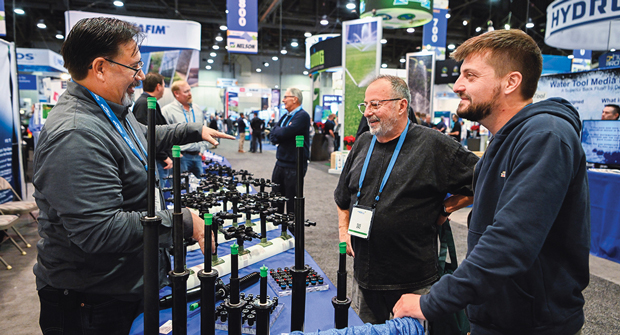USGA research grant reaches key milestone in protecting pollinators
The USGA’s multiyear collaboration with Audubon International has reached a key milestone by creating 1,000 acres of pollinator habitat on courses across America through the Monarchs in the Rough initiative.
The association’s $100,000 grant, delivered through the USGA Turfgrass Environmental Research Program in 2018, has helped deliver milkweed seed and educational resources at no charge to golf courses. A significant number of the more than 700 courses that have participated in the program are open to the public or are municipally owned.
Milkweeds are the only plants that monarch caterpillars eat, which makes the plants crucial to the life and migration of monarchs each year. Monarch butterflies, as well as many other pollinators, also feed on the nectar of milkweed flowers.
In his June column, Golfdom’s Research Editor Mike Kenna shares how USGA’s Monarchs in the Rough initiative can make a difference in butterfly and pollinator conservation.
USGA says monarch populations have declined by 90 percent and pollinator loss has a big impact on communities that rely on the benefits that they and other pollinators provide. Naturalized areas on a golf course provide natural beauty and an ecosystem and critical habitat for other wildlife and can filter stormwater runoff, improving the quality of surface and groundwater.
“Golf courses can serve as wildlife sanctuaries when they are managed properly,” said Cole Thompson, director of the turfgrass and environmental research program for USGA. “Monarchs in the Rough has made it easier for golf courses to get involved by establishing and enhancing pollinator habitat that directly benefits their communities. The USGA is proud to champion this project as part of its ongoing commitment to sustainability and is excited by the program’s progress and future goals.”
The collaboration brings funding, experts and landowners together to produce a meaningful and lasting impact to communities across America. An 18-hole golf course typically provides more than 100 acres of vital green space, making it an ideal location for pollinator habitats. The USGA’s investment supported a commitment of 250 acres of Audubon International’s 500-acre goal, established under a 2018 grant award from the National Fish & Wildlife Foundation. Additional funding came from the Environmental Defense Fund, the U.S. Fish and Wildlife Service’s New Jersey Field Office, corporate sponsors and donations from the general public.
“Audubon International is proud to be leading this exciting and unique Monarchs in the Rough partnership,” said Marcus Gray, director of conservation initiatives for Audubon International. “We’re already seeing positive results from the plantings, and interest in the program continues to grow. Our thanks go out to all Monarchs in the Rough sponsors, supporters and friends who have helped it grow so quickly but, most particularly, to the golf course superintendents, without whose efforts this work could not have been completed.”
The USGA has supported the conservation efforts of Audubon International since 1991 through more than $1.5 million of grant funding. The long-standing relationship includes a $1.3 million grant toward the Audubon Cooperative Sanctuary Program, an award-winning education and certification program that helps golf courses protect the environment and preserve the natural heritage of the game. The program helps golf course managers enhance valuable natural areas and wildlife habitats, improve efficiency and protect the environment.
Audubon International was the first environmental organization to recognize the many positive impacts that sustainable golf course management can have on the quality of life, health, and economy of the communities surrounding them. The organization developed the ground-breaking book, “Sustainable Golf Courses: A Guide to Environmental Stewardship,” and established environmental standards that continue to lead the golf industry’s sustainability efforts today.
For information on how to create monarch butterfly habit at your course or in your community check out this USGA article on Establishing Monarch Butterfly Habitat on Golf Courses.










